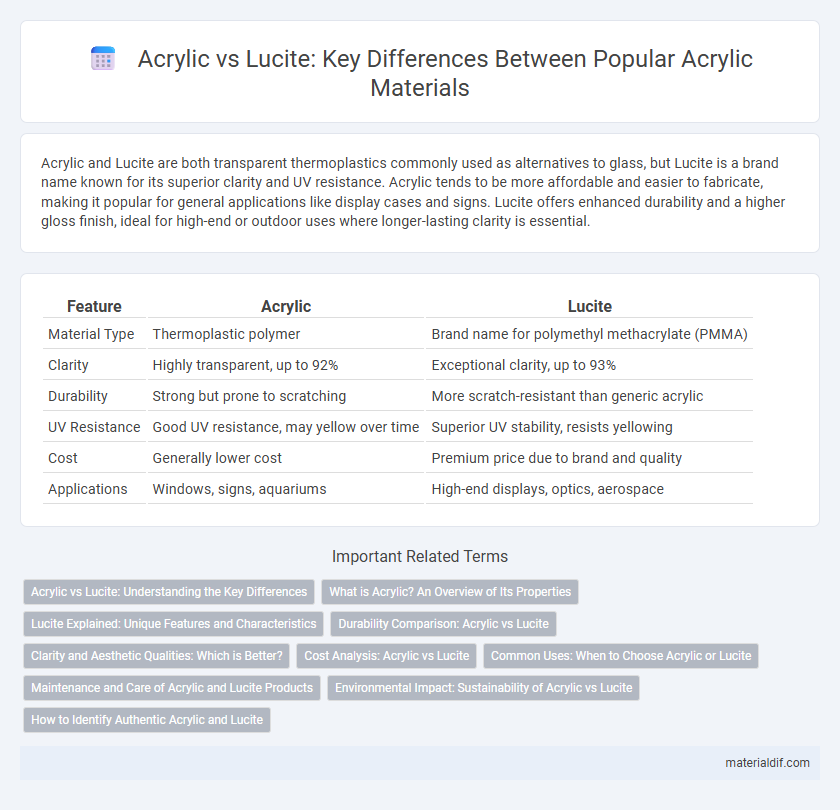Acrylic and Lucite are both transparent thermoplastics commonly used as alternatives to glass, but Lucite is a brand name known for its superior clarity and UV resistance. Acrylic tends to be more affordable and easier to fabricate, making it popular for general applications like display cases and signs. Lucite offers enhanced durability and a higher gloss finish, ideal for high-end or outdoor uses where longer-lasting clarity is essential.
Table of Comparison
| Feature | Acrylic | Lucite |
|---|---|---|
| Material Type | Thermoplastic polymer | Brand name for polymethyl methacrylate (PMMA) |
| Clarity | Highly transparent, up to 92% | Exceptional clarity, up to 93% |
| Durability | Strong but prone to scratching | More scratch-resistant than generic acrylic |
| UV Resistance | Good UV resistance, may yellow over time | Superior UV stability, resists yellowing |
| Cost | Generally lower cost | Premium price due to brand and quality |
| Applications | Windows, signs, aquariums | High-end displays, optics, aerospace |
Acrylic vs Lucite: Understanding the Key Differences
Acrylic and Lucite are both transparent thermoplastic materials commonly used as lightweight glass substitutes, but Lucite is actually a brand name for acrylic resin, distinguishing the two primarily by branding rather than composition. Acrylic offers excellent clarity, UV resistance, and weatherability, making it ideal for outdoor signage, while Lucite is often chosen for its consistent quality and optical clarity in high-end applications like display cases and aquariums. Understanding that Lucite is a type of acrylic helps clarify their interchangeable use in manufacturing, despite minor formulation variations affecting durability and finish.
What is Acrylic? An Overview of Its Properties
Acrylic, a transparent thermoplastic polymer known as polymethyl methacrylate (PMMA), exhibits exceptional clarity, high impact resistance, and UV stability, making it ideal for various applications such as windows, displays, and signage. Its lightweight nature and outstanding weather resistance enhance durability compared to glass and other plastics like Lucite, a specific brand of acrylic. Acrylic's versatility, chemical resistance, and ease of fabrication contribute to its widespread use in construction, automotive, and artistic projects.
Lucite Explained: Unique Features and Characteristics
Lucite is a brand name for a type of acrylic known for its superior clarity, UV resistance, and durability compared to standard acrylic sheets. Its unique polymer composition allows Lucite to maintain high optical transparency and resist yellowing and weathering over time, making it ideal for outdoor applications and high-visibility displays. The material's excellent impact strength and ease of fabrication also distinguish Lucite from generic acrylic variants, offering both aesthetic and functional advantages.
Durability Comparison: Acrylic vs Lucite
Acrylic and Lucite are both durable materials commonly used in signage, displays, and furniture, but Lucite offers superior impact resistance and clarity, making it less prone to chipping and cracking compared to standard acrylic. Acrylic tends to be more flexible and cost-effective, yet it scratches more easily and can yellow over time, whereas Lucite maintains clarity and resists UV degradation better. For applications requiring enhanced durability and longevity, Lucite is often preferred due to its higher resistance to wear and environmental damage.
Clarity and Aesthetic Qualities: Which is Better?
Acrylic offers high clarity with excellent light transmission, making it ideal for applications that demand transparency and brightness. Lucite, a branded form of acrylic, is known for its superior optical clarity and depth, often preferred for premium aesthetic projects. When comparing clarity and aesthetic qualities, Lucite generally provides a more refined finish with enhanced brilliance, while standard acrylic remains a cost-effective alternative with good visual appeal.
Cost Analysis: Acrylic vs Lucite
Acrylic typically costs 20-40% less than Lucite, making it a more budget-friendly option for large-scale projects and everyday use. Lucite, known for its superior optical clarity and durability, justifies its higher price point but may not be cost-effective for all applications. Evaluating project requirements and budget constraints helps determine whether the premium cost of Lucite offers sufficient value over acrylic's affordability.
Common Uses: When to Choose Acrylic or Lucite
Acrylic and Lucite both serve versatile roles in signage, displays, and protective barriers, with acrylic favored for cost-effective, impact-resistant solutions and Lucite chosen for its superior clarity and UV resistance. Acrylic is common in DIY projects, aquariums, and outdoor signage where durability under varying conditions is crucial, while Lucite is preferred in luxury displays, optical lenses, and museum-grade cases requiring pristine transparency. Choosing between the two depends on budget constraints, required optical quality, and longevity under environmental exposure.
Maintenance and Care of Acrylic and Lucite Products
Acrylic products require gentle cleaning with a soft, lint-free cloth and mild soap to prevent scratches and maintain clarity, while harsh chemicals can cause clouding or damage. Lucite, a brand-specific type of acrylic, shares similar care instructions but is more resistant to yellowing and abrasion, allowing for slightly less frequent maintenance. Both materials benefit from avoiding abrasive cleaners and exposure to direct sunlight to preserve their appearance and durability over time.
Environmental Impact: Sustainability of Acrylic vs Lucite
Acrylic and Lucite, while both types of polymethyl methacrylate (PMMA), differ in their environmental impact due to manufacturing processes and recyclability. Acrylic production tends to consume less energy and generates fewer emissions, making it more sustainable compared to Lucite, which involves more intensive processing and chemical additives. Both materials are recyclable, but acrylic's greater availability in recycling facilities and longer life cycle enhance its position as the eco-friendlier option in sustainable design.
How to Identify Authentic Acrylic and Lucite
Authentic acrylic can be identified by its clarity, hardness, and resistance to yellowing over time, often displaying a smooth, glass-like surface with a faint plastic scent when cut. Lucite, a brand name for a type of acrylic resin, is distinguished by its higher gloss and superior optical clarity, often used in premium furniture and jewelry. Testing methods such as a flame test, where genuine acrylic melts and gives off a faint plastic odor without burning, help differentiate authentic materials from imitations or other plastics.
Acrylic vs Lucite Infographic

 materialdif.com
materialdif.com